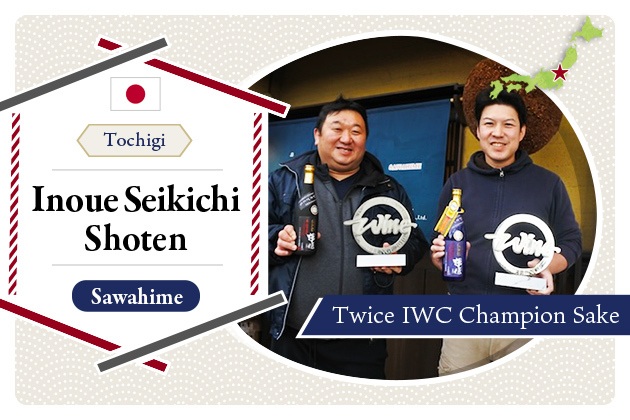
2019.01
21
Hot or cold? The perfect temperature for your sake
One unique characteristic of Japanese sake compared to wine or beer is that it can be enjoyed at a wider range of temperatures.
Changing the temperature even slightly can alter the aroma and taste, and therefore the same sake can be joined in multiple ways depending on your mood! At the same time, if you have it at the wrong temperature it can also ruin the sake, killing the very features that make it!
Here I will be sharing with you how sake changes at different temperatures as well as how to select a suitable temperature according to the type of sake.
Expressing the temperature
The three most commonly used terms to express the temperature for serving sake are: reishu, jo-on, and atsukan.
- 'hiya(冷酒)' is served roughly at 5-20˚C
- 'jo-on(常温)' is served roughly at 20-30˚C
- 'atsukan(熱燗)' is served roughly at 30-55˚C を指します。
There also exists subtler terms. For example if you ask for 'hito hada kan' (served at body temperature) then it may win you an impressed look by the server, although chances are that they may not understand you unless it is a sake bar or has a kikisake-shi (master of sake).
| Name | Temperature˚C |
|---|---|
| Yuki-bie(雪冷え) | 5 |
| Hana-bie(花冷え) | 10 |
| Suzu-hie(涼冷え) | 15 |
| Hinata-kan(日向燗) | 30 |
| Hitohada-kan(人肌燗) | 35 |
| Nuru-kan(ぬる燗) | 40 |
| Jo-kan(上燗) | 45 |
| Atsukan(熱燗) | 50 |
| Tobikiri-kan(飛切り燗) | 55〜 |
The effects of chilling sake
So what actually happens to the sake when you change the temperature? We’ll start by taking a look at the changes from cooling sake.
- the aroma is more contained, but enhances freshness
- a sharper taste that is more crisp
- the umami can become less readily recognized
- can enhance bitterness and acidity
Sake served at too low a temperature is also not desirable and is best to avoid going below 5˚C. Any lower than this and you risk trapping the aroma and taste, losing the fragrance and umami that is so distinctive to Japanese sake.
The effects of heating sake
What about when you heat sake? In general, you can expect the opposite effects from when you chill sake as described above.
- more expansive aroma
- a more rounded taste, well blended
- richer umami
- higher alcoholic percentage and drier in flavour
Heating sake too much is also not recommended as it can become too alcoholic or lose its aroma.
Which temperature for which sake?
So how can we tell which sake is best served hot or cold?
The answer is the temperature that will best highlight the unique characters of that sake. For example, if the particular sake has a fresh quality, then serving it cold will better enhance this freshness. Conversely, if it is a Japanese umami that this sake possesses, then serving it hot can make it even more blended and rounded in taste.
Here we introduce the 4 groupings of sake as classified by the Sake Service Institute (SSI) and the recommended temperature at which to enjoy these.
Aromatic Sake (Kun-shu 薫酒)- Japanese sake high in fragrance
(ex.: Junmaidaiginjo, Junmaiginjo, Daiginjo, Ginjo, etc.) Recommended serving temperature: 8-15˚C
This type of sake boasts freshness and an elegant fragrance and is best served cold. However, don’t overdo it as the fragrance might be lost, whilst also drawing out too much acidity or bitterness.
Refreshing Sake (So-shu 爽酒) - light and easy to drink
(ex.: Namazake, Hiyaoroshi, Honjozo, Futsushu) Recommended serving temperature: 5-10˚C
With a refreshing taste full of freshness, this type of sake is best enjoyed chilled. Compared to aromatic sake, it has less bitterness and acidity to begin with and therefore you are less likely to risk over-chilling it.
Rich Sake (Jun-shu 醇酒) - sake with a rich body
(ex.: Junmaishu. (Especially Kimoto, Yamahai, Genshu, Muroka Types)) Recommended serving temperature: 15-20˚C or 40-55˚C
This type of sake changes the most with the temperature. It is best served warm to fully enjoy the rich flavour of the rice as well as its umami.
Aged Sake (Juku-shu 熟酒) - aged sake with a longer maturing period
(ex.: Koshu) Recommended serving temperature: 15-40˚C
This group includes sake ranging from fresh to aromatic and each will have a different most suited to it. As a rule of thumb, anything that is more aromatic with stronger umami should be served at a higher temperature, while those that have a freshness should be served at a lower temperature.
To conclude
Now that you know how sake behaves at varying temperatures, you can play with this unique characteristic to enjoy the many faces of each sake. Use it to explore the rich world that Japanese sake offers!
Pickup Articles
2019.01.18
2019.01.25
Trending Articles
Popular Articles
Recent Articles












